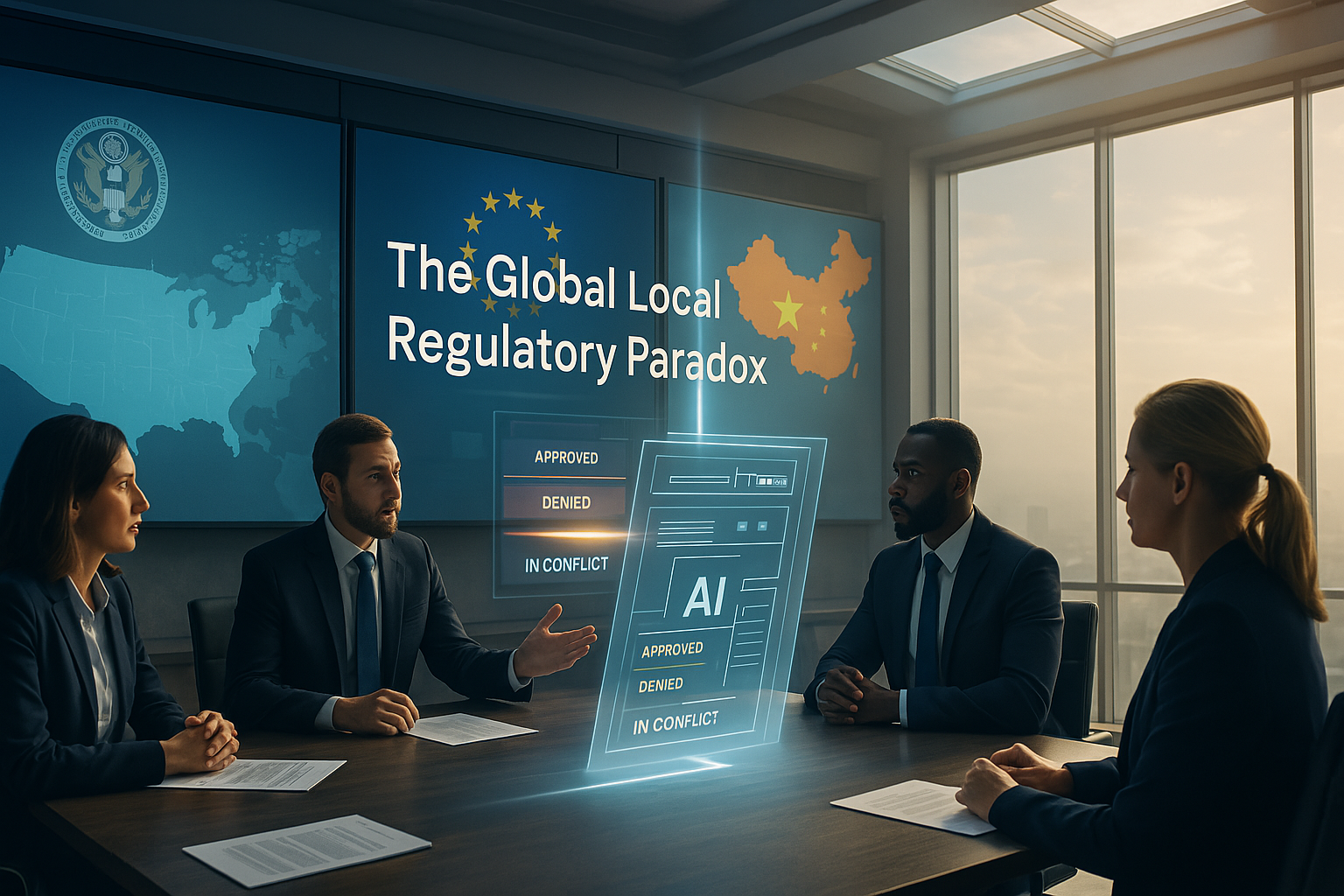Artificial intelligence systems do not respect borders. Data flows freely, models are deployed remotely, and developers often serve a global user base. But laws and compliance frameworks remain rooted in national or regional jurisdictions. This misalignment creates the Global Local Regulatory Paradox—a growing challenge for organizations deploying AI at scale.
In earlier articles, we explored the Transparency Paradox and the Autonomy Accountability Paradox. Here, we examine how regulatory fragmentation adds new layers of complexity to AI governance and what strategies organizations can adopt to manage it effectively.
What the Global Local Regulatory Paradox Means
AI development and deployment typically span countries and continents. Cloud-based infrastructure, multinational teams, and globally distributed users are the norm. However, regulation remains local. Each jurisdiction applies its own rules, reflecting local laws, ethics, values, and political priorities.
This paradox becomes clear when one AI system must simultaneously comply with the EU AI Act, U.S. sector-specific rules, and China’s centralized AI controls. What is permissible in one country may be restricted—or even prohibited—in another.
For instance, the EU categorizes AI systems by risk and mandates transparency and documentation for high-risk applications. In contrast, the U.S. lacks a unified framework and instead regulates AI through a patchwork of agencies, each focused on a specific sector. Meanwhile, China imposes pre-approval regimes and algorithmic audits, particularly for generative AI and public-facing tools.
The paradox is not just about conflicting rules—it’s about building AI systems for a global market while navigating incompatible compliance environments.
Why This Paradox Challenges Governance Teams
Governance professionals must align internal policies with a variety of external legal demands. The more jurisdictions an AI system operates in, the more layered and inconsistent those demands become.
Variations across regions include:
- How AI risk is classified
- What kind of data may be used, and under what conditions
- The level of transparency and documentation required
- Audit obligations and timelines
These differences create legal uncertainty and operational inefficiencies. Organizations must spend significant resources interpreting, reconciling, and updating their governance frameworks to remain compliant.
Smaller companies face disproportionate burdens. Without dedicated legal teams or global infrastructure, they struggle to keep up with evolving requirements. This disparity raises concerns about fairness, competitiveness, and innovation in the AI space.
Legal and Operational Tensions in Fragmented Regulation
Operating across borders means navigating not only different rules but sometimes conflicting ones. A system’s transparency model may meet EU expectations but fall short under U.S. data privacy laws or Chinese algorithm reporting requirements.
This creates real operational dilemmas. Standardizing internal practices becomes difficult when local laws pull in different directions. Multinational teams may implement controls for one region that inadvertently conflict with those required elsewhere.
For example, data governance protocols designed around GDPR may need significant adaptation to comply with China’s Personal Information Protection Law or California’s Consumer Privacy Act. Similarly, AI explainability requirements may differ between the EU’s risk-based approach and the NIST AI Risk Management Framework used in the U.S.
These tensions highlight why global compliance cannot be reduced to a checklist. It must be treated as an adaptive, multi-layered governance challenge.
Strategies for Navigating the Global Local Regulatory Paradox
Governance frameworks must be structured to absorb and respond to regulatory complexity. Rather than treating compliance as a static requirement, organizations can adopt dynamic strategies that provide flexibility without compromising oversight.
One effective model is the core plus localization approach. This means establishing a universal governance foundation—covering ethical principles, risk assessments, and data handling—while allowing local teams to adapt specific components to match regional laws.
Other useful strategies include:
- Designing modular policies with interchangeable parts for different jurisdictions
- Appointing regional compliance leads to track and interpret local regulations
- Participating in international standards bodies and regulatory forums
- Aligning internal documentation with emerging global norms, such as ISO/IEC 42001
These efforts reduce duplication and legal exposure while allowing the organization to adapt more quickly to regulatory changes across borders.
What Regulators Expect from Cross-Border AI Systems
Despite differences in local laws, regulators are beginning to recognize the importance of coordination. Initiatives such as the G7 Hiroshima Principles, OECD AI recommendations, and ISO standardization efforts are all working toward greater interoperability across regulatory frameworks.
For instance, the EU encourages alignment with its AI Act even by third countries, particularly when companies target EU markets. In the U.S., agencies like the FTC and NIST provide guidance-oriented models that emphasize risk management while avoiding rigid mandates. China continues to enforce centralized oversight but still engages in international discussions on AI ethics and governance.
Overall, regulators increasingly expect organizations to identify and manage cross-border risks, maintain robust internal oversight of AI operations, and adapt their governance frameworks proactively in response to emerging global requirements. Companies that can demonstrate this kind of structured, forward-looking approach will be in a stronger position to build trust and maintain access in competitive international markets.
These international expectations form a key part of the AIGP exam curriculum. The AIGP Prep Suite 2025 Edition offers structured preparation on cross-border compliance, global frameworks, and jurisdictional risk management—critical knowledge for professionals working in international AI contexts.
Designing AI Governance for a Global Environment
Organizations operating in multiple jurisdictions should formalize global governance structures. This could include creating a central AI policy team with regional liaisons or assigning global leads for high-risk AI applications.
Mapping internal policies to regional laws helps identify overlaps, gaps, and inconsistencies. This process should feed into governance reviews, documentation updates, and staff training.
Prioritization is also key. Not all jurisdictions carry equal risk. Governance teams should focus deeply on regions with high regulatory maturity or significant market exposure—such as the EU, U.S., and China—while applying lighter frameworks elsewhere until laws evolve.
Designing for global governance is not just about legal compliance. It’s about enabling AI systems to operate safely, responsibly, and efficiently wherever they are deployed.
Conclusion
The Global Local Regulatory Paradox is one of the most complex challenges in AI governance. While AI systems are inherently global, the rules that govern them are deeply local. Navigating this fragmentation requires more than legal expertise—it demands structural foresight, organizational flexibility, and proactive engagement with regulatory developments.
By building modular, adaptive governance frameworks, aligning with international standards, and focusing on high-risk jurisdictions, organizations can reduce compliance friction and support global AI deployment. As we continue this series on AI governance paradoxes—including earlier articles on transparency and accountability—this paradox reminds us that governing AI is not just a technical task. It’s a strategic one, shaped by culture, geography, and politics as much as by data and code.






